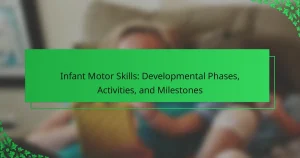
What is Early Language Acquisition?
Early language acquisition is the process by which infants and young children learn to understand and communicate using language. This process typically begins at birth and continues through early childhood. Children acquire language through exposure to speech and interaction with caregivers. They learn to recognize sounds, words, and sentence structures. Research shows that by age three, children can understand and produce simple sentences. Studies indicate that early exposure to language significantly impacts cognitive development. For instance, children who engage in conversations with adults demonstrate advanced language skills later in life.
How does Early Language Acquisition develop in children?
Early language acquisition develops in children through a series of stages influenced by interaction and exposure. Initially, infants engage in cooing and babbling, which lays the groundwork for speech. As children grow, they begin to understand simple words and phrases by around 12 months. By 18 months, vocabulary expands rapidly, often reaching around 50 words.
Social interaction plays a crucial role during this phase. Children learn language through conversations with caregivers and peers. Repetition and reinforcement help solidify their understanding. By age two, many children can form simple sentences. Research indicates that interactive reading and communication significantly enhance language skills.
Studies show that the quality of linguistic input affects vocabulary development. Programs promoting rich verbal interaction can lead to better language outcomes. Overall, early language acquisition is a dynamic process shaped by both biological readiness and environmental factors.
What are the key stages of Early Language Acquisition?
The key stages of Early Language Acquisition include the pre-linguistic stage, holophrastic stage, two-word stage, and telegraphic speech stage. The pre-linguistic stage occurs from birth to around 12 months. During this time, infants communicate through crying, cooing, and babbling. The holophrastic stage follows, typically between 12 to 18 months. In this stage, children use single words to convey entire ideas, like saying “milk” to mean “I want milk.” The two-word stage emerges from 18 to 24 months. Here, children start combining two words to form simple sentences, such as “want cookie.” Lastly, the telegraphic speech stage occurs from 24 to 30 months. At this stage, children use short, simple phrases that include essential words, like “mommy go.” These stages reflect a child’s progression in understanding and using language.
How do environmental factors influence Early Language Acquisition?
Environmental factors significantly influence early language acquisition. These factors include the quality of interactions between caregivers and children. Rich linguistic environments promote vocabulary development. Frequent verbal communication enhances language skills. Exposure to diverse vocabulary increases comprehension and expression. Social interactions are essential for practicing language use. Studies show that children in stimulating environments outperform peers in language skills. Research by Hart and Risley indicates that children exposed to more words develop larger vocabularies.
Why is Early Language Acquisition important for child development?
Early language acquisition is crucial for child development because it lays the foundation for effective communication skills. It enhances cognitive abilities, including problem-solving and critical thinking. Children who acquire language early show better literacy skills later in life. Research indicates that early exposure to language-rich environments boosts vocabulary acquisition. According to a study by Hart and Risley (1995), children from language-rich homes heard 30 million more words by age three than those from less stimulating environments. This disparity significantly impacts academic success and social skills. Thus, early language acquisition is essential for holistic child development.
What cognitive benefits are associated with Early Language Acquisition?
Early language acquisition enhances cognitive development significantly. It improves memory skills in young children. Research shows that children exposed to multiple languages perform better in problem-solving tasks. Early language skills also correlate with higher IQ levels. Additionally, children who acquire language early exhibit better attention and focus. They develop critical thinking skills more rapidly than their peers. Studies indicate that early language exposure leads to advanced literacy skills later in life. Overall, early language acquisition lays a foundation for lifelong cognitive benefits.
How does Early Language Acquisition affect social skills?
Early language acquisition significantly enhances social skills. Children who acquire language early tend to develop better communication abilities. These abilities include understanding and using verbal and non-verbal cues. Effective communication fosters relationships with peers and adults. Research indicates that children with strong language skills engage more in social interactions. They are also better at expressing their feelings and understanding others’ emotions. A study by Hart and Risley (1995) found that children exposed to rich language environments had superior social competencies. This correlation highlights the importance of early language experiences in shaping social development.

What strategies can be used to support Early Language Acquisition?
Engaging in interactive reading is a key strategy to support early language acquisition. This involves reading aloud to children and encouraging them to participate. Using expressive voices and gestures helps maintain their interest. Additionally, asking open-ended questions during reading fosters critical thinking and language use. Incorporating songs and rhymes introduces new vocabulary in a fun way. Repetition of words and phrases reinforces language learning. Providing a rich language environment with diverse vocabulary enhances comprehension. Lastly, modeling language through everyday conversations encourages children to express themselves.
How can parents encourage language development at home?
Parents can encourage language development at home by engaging in regular conversations with their children. Speaking clearly and using a rich vocabulary exposes children to new words. Reading books together is another effective strategy. It helps children understand sentence structure and context. Singing songs and nursery rhymes also promotes language skills. These activities enhance memory and rhythm in language. Additionally, asking open-ended questions encourages children to express their thoughts. Responding positively to their attempts at communication boosts their confidence. Research indicates that children who experience interactive reading show improved language skills.
What role do reading and storytelling play in Early Language Acquisition?
Reading and storytelling are crucial for early language acquisition. They expose children to vocabulary, sentence structure, and narrative skills. Engaging with stories enhances comprehension and listening abilities. Research shows that children who are read to regularly develop stronger language skills. A study by the National Institute for Literacy indicates that early exposure to reading correlates with later literacy success. Storytelling fosters imagination and encourages verbal expression. It allows children to practice language in a meaningful context. Overall, reading and storytelling significantly contribute to the foundation of language development in young children.
How can interactive play enhance language skills?
Interactive play enhances language skills by providing opportunities for communication and social interaction. During play, children express themselves, ask questions, and respond to others. This engagement promotes vocabulary development and understanding of language structure. Research shows that children involved in interactive play demonstrate improved language outcomes. For instance, a study by Weitzman and Greenberg (2002) found that children who participated in interactive play with caregivers had larger vocabularies. Additionally, play scenarios encourage the use of new words in context, reinforcing learning. Overall, interactive play serves as a vital tool for language acquisition in early childhood.
What techniques can educators employ to foster language skills in the classroom?
Educators can employ various techniques to foster language skills in the classroom. Interactive reading sessions enhance vocabulary and comprehension. Storytelling engages students and encourages expressive language use. Group discussions promote speaking and listening skills. Role-playing activities build conversational abilities and confidence. Visual aids support language learning through contextual understanding. Vocabulary games make learning fun and memorable. Writing exercises develop grammar and composition skills. These techniques are effective in creating a language-rich environment that supports early language acquisition.
How does creating a language-rich environment support learning?
Creating a language-rich environment supports learning by enhancing vocabulary and language skills. Such environments provide ample opportunities for children to hear and use language in context. Exposure to diverse language forms fosters better comprehension and communication abilities. Research shows that children in language-rich settings demonstrate improved literacy skills. For instance, a study by Hart and Risley (1995) found that children from language-rich homes had larger vocabularies by age three. Engaging with varied language also promotes critical thinking and problem-solving skills. Overall, these environments are crucial for cognitive and social development in early learners.
What are effective group activities for promoting language acquisition?
Effective group activities for promoting language acquisition include role-playing, group storytelling, and language games. Role-playing allows participants to practice real-life scenarios in a supportive environment. This method enhances vocabulary and conversational skills. Group storytelling encourages creativity and collaborative language use. Participants build narratives together, which reinforces language structures. Language games, such as word bingo or charades, make learning interactive and fun. These activities boost engagement and retention of new vocabulary. Research shows that interactive group activities significantly improve language skills among learners.

How can communication be encouraged during Early Language Acquisition?
Communication can be encouraged during Early Language Acquisition through interactive activities. Engaging in conversations with children promotes language skills. Reading aloud to children introduces vocabulary and sentence structure. Singing songs and nursery rhymes enhances phonemic awareness. Using gestures and [censured] expressions supports understanding. Providing a rich language environment stimulates interest in communication. Encouraging play-based learning fosters social interaction and language use. Research shows that early exposure to language positively impacts cognitive development.
What are the best practices for facilitating communication in young children?
Best practices for facilitating communication in young children include using simple language, engaging in interactive play, and encouraging open-ended questions. Simple language helps children understand and respond effectively. Interactive play fosters natural communication, allowing children to express themselves. Open-ended questions stimulate critical thinking and deeper conversation. Additionally, reading regularly to children enhances vocabulary and comprehension skills. Modeling good communication by actively listening and responding encourages children to mimic these behaviors. Creating a supportive environment where children feel safe to express their thoughts is crucial. These practices are supported by research indicating that early communication skills significantly impact later language development and literacy.
How can parents model effective communication skills?
Parents can model effective communication skills by actively listening and responding thoughtfully. They should maintain eye contact to show engagement. Using clear and age-appropriate language enhances understanding. Parents can also encourage open dialogue by asking open-ended questions. Demonstrating empathy in conversations builds trust and connection. Practicing turn-taking during discussions teaches conversational skills. Additionally, using positive body language reinforces messages. Research indicates that children who observe effective communication at home are more likely to develop similar skills.
What strategies can be used to promote active listening in children?
To promote active listening in children, use strategies such as modeling attentive behavior. Adults should demonstrate focused listening during conversations. Encourage children to maintain eye contact while listening. This reinforces the importance of engagement. Use open-ended questions to foster discussion. This allows children to express their thoughts and feelings. Implement activities like storytelling to enhance listening skills. Interactive games that require listening can also be effective. Regular practice of these strategies helps develop active listening over time.
What common challenges may arise during Early Language Acquisition?
Common challenges during early language acquisition include limited vocabulary, pronunciation difficulties, and understanding grammar. Limited vocabulary can hinder a child’s ability to express needs and thoughts. Pronunciation difficulties may lead to misunderstandings and frustration in communication. Understanding grammar rules can be complex for young learners. Additionally, some children may experience delays in speech development. Environmental factors, such as lack of exposure to language, can also impact language acquisition. Social interactions play a crucial role; children may struggle to engage with peers. These challenges can affect overall communication skills and confidence in language use.
How can parents and educators address speech delays?
Parents and educators can address speech delays by implementing targeted interventions and strategies. They should engage children in regular conversations to promote language use. Reading aloud to children enhances vocabulary and comprehension skills. Using visual aids can help children connect words with meanings. Encouraging play-based activities fosters natural communication. Consistency in routine language practice reinforces learning. Seeking professional assessment from speech-language pathologists can provide tailored support. Research indicates that early intervention significantly improves speech outcomes.
What resources are available for supporting language development?
Resources available for supporting language development include books, educational apps, and interactive games. Books such as “The Very Hungry Caterpillar” promote vocabulary and comprehension. Educational apps like “Endless Alphabet” enhance word recognition and phonics skills. Interactive games encourage conversation and social interaction. Speech therapy services provide personalized support for children with language delays. Parent workshops offer strategies to foster language skills at home. Research shows that reading to children daily significantly boosts language acquisition. These resources collectively create a supportive environment for language development.
What practical tips can enhance Early Language Acquisition?
Engaging in interactive reading enhances early language acquisition. Reading aloud to children exposes them to new vocabulary and sentence structures. Using expressive voices and gestures makes the experience more engaging. Encouraging children to ask questions fosters curiosity and comprehension. Singing songs and nursery rhymes promotes phonemic awareness and rhythm. Providing a language-rich environment with labels and conversations supports vocabulary growth. Playing with peers encourages social language skills and turn-taking. Consistent daily routines that include language activities reinforce learning and retention.
Early language acquisition is the process through which infants and young children learn to understand and communicate using language, beginning at birth and continuing through early childhood. The article outlines the key stages of this development, including pre-linguistic, holophrastic, two-word, and telegraphic speech stages, and highlights the significant impact of environmental factors and caregiver interactions on language skills. It discusses the cognitive and social benefits associated with early language acquisition, effective strategies for parents and educators to support language development, and common challenges faced during this process, along with practical tips and resources for enhancing language skills in young children.




